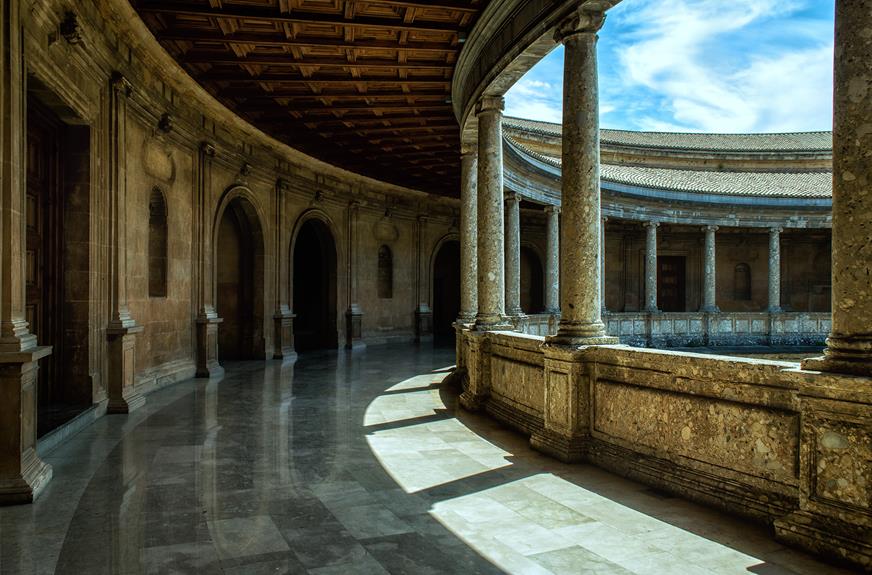
As a history enthusiast, I've always been captivated by the rich tapestry of Spain's past. From ancient Roman ruins to medieval castles and Moorish palaces, this country is a treasure trove of historical gems waiting to be explored. Join me on a journey as we uncover the stories behind Gothic cathedrals, marvel at the intricate architecture, and discover UNESCO World Heritage Sites that have stood the test of time. Get ready to step back in time and immerse yourself in Spain's fascinating history.
Key Takeaways
Table of Contents
- Ancient Roman Ruins: The Roman Theatre in Merida and the Roman Aqueduct of Segovia are well-preserved structures that showcase Roman engineering, providing a glimpse into the past and admiration for the ancient world.
- Medieval Castles and Fortresses: The Alhambra in Granada, Castillo de Santa Barbara in Alicante, and the Alcazar of Segovia transport visitors back in time, allowing them to appreciate the grandeur of medieval castles and fortresses, while highlighting Spain's commitment to heritage and preservation.
- Moorish Palaces and Architecture: Spain's exquisite Moorish palaces and architecture, influenced by the Moors, offer vibrant flavors and unique combinations of ingredients in the cuisine, enchanting Moorish gardens with meticulous design, and a Moorish legacy that shapes and enriches Spain's cultural heritage.
- Gothic Cathedrals and Churches: The Cathedral of Barcelona, the Cathedral of Toledo, and the Cathedral of Seville are awe-inspiring examples of Gothic architecture, showcasing craftsmanship and grandeur. These cathedrals and churches serve as testaments to Spain's religious heritage and architectural prowess.
Ancient Roman Ruins
What are some must-visit Ancient Roman ruins in Spain that I recommend exploring? When it comes to exploring architecture and delving into Roman history, Spain has some incredible sites to offer. One such must-visit ruin is the Roman Theatre in Merida. This well-preserved structure showcases the grandeur and sophistication of Roman engineering. As I walked through the ancient seating area and stood on the stage, I couldn't help but be in awe of the history that unfolded here. Another remarkable site is the Roman Aqueduct of Segovia. The sheer size and precision of the aqueduct is a testament to the ingenuity of Roman architecture. These ruins not only provide a glimpse into the past but also ignite a sense of wonder and admiration for the ancient world.
Medieval Castles and Fortresses
One of my favorite aspects of exploring Spain's rich historical gems is discovering its impressive collection of medieval castles and fortresses. These architectural marvels not only transport me back in time but also provide a glimpse into the country's rich history. The preservation of these medieval castles showcases Spain's commitment to its heritage and allows visitors to appreciate their grandeur.
- The Alhambra: Known for its intricate Islamic architecture, this fortress in Granada is a testament to Spain's diverse cultural history.
- Castillo de Santa Barbara: Perched atop Mount Benacantil in Alicante, this castle offers breathtaking views of the Mediterranean Sea.
- The Alcazar of Segovia: With its distinctive shape resembling the bow of a ship, this fortress has witnessed famous fortress battles and is an iconic symbol of Segovia.
Exploring these medieval castles and fortresses allows me to immerse myself in Spain's fascinating past and appreciate the beauty of their historical significance.
Moorish Palaces and Architecture
As I continue my exploration of Spain's rich historical gems, I am captivated by the exquisite Moorish palaces and architecture that seamlessly blend with the country's diverse cultural tapestry. The Moorish influence in Spanish cuisine is evident in the vibrant flavors and unique combinations of ingredients. From the use of aromatic spices like saffron and cumin to the incorporation of fruits and nuts in savory dishes, the Moorish culinary traditions have left an indelible mark on Spanish gastronomy. As I stroll through the enchanting Moorish gardens, I am struck by their meticulous design and innovative landscaping techniques. The gardens are a harmonious blend of water features, intricate tilework, and lush greenery, creating a serene and tranquil atmosphere. It is truly remarkable to witness how the Moorish legacy continues to shape and enrich Spain's cultural heritage.
Gothic Cathedrals and Churches
Continuing my exploration of Spain's rich historical gems, I am now captivated by the awe-inspiring Gothic cathedrals and churches that adorn the country's architectural landscape. The Gothic architecture in Spain is a testament to the intricate craftsmanship and grandeur of the era. Here are some famous Spanish churches and cathedrals that you must visit:
- The stunning Cathedral of Barcelona, with its towering spires and intricate stone carvings.
- The majestic Cathedral of Toledo, known for its ornate interiors and breathtaking stained glass windows.
- The iconic Cathedral of Seville, boasting the largest Gothic altarpiece in the world.
These remarkable structures not only showcase Spain's religious heritage but also serve as a testament to the country's rich history and architectural prowess. Prepare to be mesmerized by the beauty and grandeur of these Gothic masterpieces.
UNESCO World Heritage Sites
I am now going to delve into the fascinating topic of UNESCO World Heritage Sites in Spain. Spain is blessed with a rich cultural and historical heritage, and its UNESCO world heritage sites are a testament to its remarkable past. These sites have been recognized for their outstanding universal value and are carefully preserved for future generations to appreciate and learn from. From the stunning Alhambra in Granada to the iconic Sagrada Familia in Barcelona, these sites showcase the incredible architectural, artistic, and historical achievements of Spain. Preservation efforts play a crucial role in maintaining the integrity and authenticity of these sites, ensuring that they remain accessible and well-preserved for years to come. By protecting these invaluable treasures, Spain continues to celebrate its history and share its cultural heritage with the world.
Frequently Asked Questions
How Can I Book a Guided Tour of the Ancient Roman Ruins in Spain?
I can book a guided tour of the ancient Roman ruins in Spain by checking online for tour companies. They will have information on availability and the booking process for these historical gems.
Are There Any Specific Dress Codes or Restrictions When Visiting Medieval Castles and Fortresses in Spain?
Nope, no dress codes or photography restrictions when exploring medieval castles and fortresses in Spain. You're free to snap pics and wear whatever you please to fully immerse yourself in the history.
What Are the Best Times of the Year to Visit the Moorish Palaces and Architecture in Spain?
The best times to visit Moorish palaces in Spain are during the spring and fall seasons. The weather is pleasant, and there are fewer crowds, allowing for a more enjoyable and immersive experience.
Are There Any Specific Rules or Regulations When Visiting Gothic Cathedrals and Churches in Spain?
When visiting gothic cathedrals and churches in Spain, there are specific rules and regulations to follow. It's important to know what to do and what not to do to respect the sacred spaces.
How Can I Find More Information About the Specific UNESCO World Heritage Sites in Spain?
To find detailed information about UNESCO World Heritage sites in Spain, I recommend visiting the official UNESCO website. They have a comprehensive list of all the sites and provide in-depth information about their historical significance.




Leave a Reply
You must be logged in to post a comment.